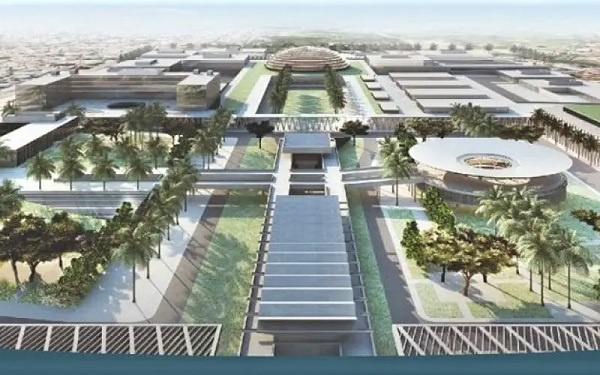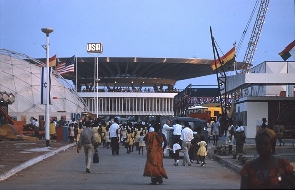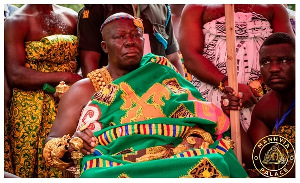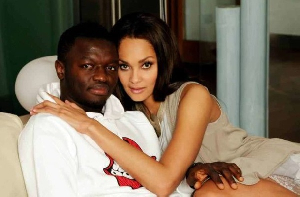In February 1967, Ghana hosted an International Trade Fair on new grounds near the sea in the historic coastal town of La (also known as “Labadi”).
The purpose-built facility was a gleaming sprawl of stalls, exhibition stands, majestic emporiums, and lush tree-lined avenues.
Over a three week period, the magnificent African Pavilion became the center of gravity in an affair that had drawn 2000 commercial and industrial exhibitors from 33 countries to this breezy corner of Accra.
The international Ghanaian-Polish design team responsible for the Trade Fair’s design spared no effort in imbuing the structures with architectural significance.
Trade Fair was to serve as a pulsing artery connecting the redevelopment of old coastal towns like Labadi with the modernisation of the capital’s waterfront and the broader urbanography of commerce and industry in what was even then a serious contest between planning, on one hand, and overpopulation and poverty, on the other hand.
None of those strategic objectives have been met in nearly 60 years. In today’s policy language, they are recognisable in some contemporary projects such as the following: Accra Marine Drive, the Accra Urban Transport Project, Airport City Phase 2, and, of course, the Ghana Trade Fair Redevelopment Project.
Sadly, every one of these projects is plagued with confusion, rampant insider dealing, perennial delay, and disconnection from its original urban-transformation and light-industrial objectives. But in this short piece, we intend to only talk about the Ghana Trade Fair Center (“Trade Fair”) redevelopment affairs.
From the plans based on which Trade Fair was constructed by the Ghana National Construction Company over a five-year period, it is clear that the Osagyefo (Kwame Nkrumah) government saw the project as strongly linked to Ghana’s export promotion goals and Pan-African trade hub/gateway ambitions.

Aerial Plan of the Ghana Trade Fair Center
Source: Stanek (2015)
Long before the now famous AfCFTA would be birthed, the blueprint for the eventual fair that opened in 1967 underscored the need to highlight both “made in Ghana” products and trade across African countries in equal measure. In a kind of early version of today’s “single African market” dream.

Frontpage of the Daily Graphic edition of 11th February, 1976
The Trade Fair center in the years after its launch served the purpose of showcasing innovations in production, especially of manufactures, across the country that would otherwise not have come to the limelight. Small businesses, maverick inventors, industrial startups in suburbia, and cooperatives in the hinterland were particularly keen to secure stands during fairs to catch the eyes of potential customers and investors. But they were equally keen to attract press attention and, directly or indirectly, the focus of officialdom. In the first decade or so, Trade Fair management would produce meticulous catalogs listing the exhibitors and their contact details to facilitate such discoveries.

Image Source: Penn Museum
For example, Ghanaian scientist, Narh Naatey, was one of the early researchers who honed in on the issue of malaria parasites developing resistance to chloroquine. So, he invented a herbal formula called Nasra tablets to circumvent the parasite’s learning behaviour. But how to commercialise and distribute? In 1988, he showed up at the Trade Fair exhibition of that year and displayed his wares.
The Ministry of Science & Technology saw his display and committed resources to develop and promote the product. Difficulties navigating the bureaucracy of the Health Ministry ultimately prevented this early product from becoming Ghana’s own Coartem well before Coartem was invented in 1992. But at least Dr. Naatey got a fighting chance because the Trade Fair brought him into contact with supporters. Such was its influence.
As with all state-owned/run facilities in Ghana, the facilities of the Trade Fair soon started to suffer neglect. Poor maintenance practices crept in steadily, and some of its world-class architecture began to fade. Nevertheless, the emphasis on export-promotion, foreign investment (FDI) into local manufacturing, and light industry (especially by small businesses) never wavered, as one can easily glean from a centerspread in the Daily Graphic edition of 13th February, 1976.

In those days, the Trade Fair and its periodic exhibitions were clearly seen as a major fulcrum around which small businesses could accrete visibility, support, and growth. And through business growth, the country’s industrial ambitions, FDI attraction hopes and export promotion plans would all, hopefully, come together coherently and cohesively.
As the country’s economy went through the ups and downs of the 70s and 80s, Trade Fair’s maintenance issues continued to mount. Successive governments tried to hold things together, but by the early 90s, it was clear that something drastic needed to be done. The decision was taken to redesign the business model by transforming the Trade Fair grounds into a permanent hub for business promotion, thus ending the overreliance on the annual fairs and occasional large exhibitions (such as the quadrennial ECOWAS fair). Businesses were invited to do more at and with the Trade Fair, as the ad below in 1992 shows.

Thus began the practice of more and more businesses situating various facilities permanently on the Trade Fair grounds. Some small businesses obtained favourable locations in easy reach of Accra’s bustling center to produce and sell their various wares. Trade associations acquired offices there. Rent became a major source of non-state income for the operators of the Trade Fair, now reincorporated as a limited liability company and placed on a path to full commercial sustainability.
Management issues, however, continued to dog the Trade Fair. Political appointments at the helm, as it always does, blunted competitive edge and encouraged poor planning and execution. After a particularly disastrous ECOWAS Fair in 1999, the Chief Executive was suspended and committees set up to probe general management failures. But little by way of radical change occurred. Trade Fair continued to fall short of the lofty heights set by the original vision.
Nevertheless, despite the struggle to fulfil its bigger vision, Trade Fair still strove to advance the goal of showcasing entrepreneurial efforts towards local industrialisation. In 2006, for instance, a major focus of the international fair held that year was on promoting joint ventures to strengthen the ability of local companies to harness Ghana’s natural endowments.

By 2015, weak management had ensured that the new business model had been so poorly executed that resources were simply not available to properly maintain the facilities. Pictures started to circulate in the press of rotting buildings and leaking roofs. The hub of the 1967 African Pavilion (nicknamed “the round pavilion”), an architectural jewel of great historical significance, was slowly decaying.

Round Pavilion in 2016
Image Source: Nii Smiley Byte

Round Pavilion in its original glory.
Source: Rymaszewski (1967)
The government was jolted into action. A comprehensive plan for redevelopment that had been in the works for eons was expedited to completion. A competitive tendering process then followed, overseen by PricewaterhouseCoopers (PWC). The Reroy Group emerged as the winners, and efforts began to develop a roadmap and strategy for implementation. Before any of this could come to fruition, the government of the day lost power in the 2016 general elections.
The new government, as is the custom, sacked all the senior officials (about three-dozen in one go). It then installed an optometrist at the helm of the company. And appointed a shipping cargo millionaire as Chair of the Board. The new Chief Executive wasn’t exactly known for previous work turning around complex industrial and commercial real estate facilities, but she had something far more important going for her: she had been an executive of the ruling party in one of the party’s overseas branches in Georgia, United States.
Efforts began to systematically dismantle every single block in the Trade Fair edifice. The new masterplan for redevelopment was promptly ditched. Adjaye Associates, being the flavour of the month in Ghana, was called in. Large multimillion dollar projects were being parceled and dished to the firm on a silver platter, and Trade Fair joined the list. As is customary, even the pretense of a competitive bid was unnecessary. Architects who had won fair design bids in connection with the project protested, and were routinely ignored. But this was only the beginning.
In an act of extraordinary brazenness, the new Trade Fair leadership sent bulldozers onto the grounds and literally stripped it of most of its historic architecture. The Round Pavillion? Desecrated. The famous Adegbite cubes? What is that? Pulverised. The Chyrosz-Rymaszewski umbrella cones? Please, get real! Violated. It is as if Attila the Hun had arrived in Rome purposely to erase every megastructure of note in the Eternal City. In one short series of overnight raids, Ghana’s only piece of significant industrial-architecture heritage was severely brutalised.

A scene of the Trade Fair in 1967
Source: Stanek (2015)
This alarming spectacle of cultural annihilation triggered nothing by way of serious protest among the Ghanaian elites. Apart from protesting the loss of contracts to regime favourite, Adjaye Associates, the architectural profession stayed eerily quiet.
It is quite likely that the entire episode would have gone unreported had the new Trade Fair management not also proceeded to wipe out the small business operators who had been attracted to the grounds since the 1990s to contribute their quota to Ghana’s industrialisation dreams. The likes of Colour Planet, a printing press, had their equipment damaged beyond repair when the bulldozers brought down their factories.

Demolished light industrial facilities at the Trade Fair.
Image Source: Daily Mail (2020)
It is really hard to fathom how this near-vandalism could have emanated from whatever new masterplan Adjaye Associates had put together. How can a world-class architectural design studio come up with a redevelopment plan that fails to fully preserve vital historic architecture and make accommodation for pre-existing viable economic activity? It is possible to understand how political authorities in a country like Ghana would occasionally oversee a planning process so shoddy that standard heritage preservation and economic rights considerations are tossed aside, but it is much harder to envisage how their conduct might be enabled by world-class architects.
Anyway, in one fell swoop, the new management of Ghana’s Trade Fair expired the last traces of the original vision of the site. The celebrated Ghanaian-Slavic architecture is mostly gone. The network of small businesses providing jobs and maintaining some industrial vitality in that crucial urban enclave has been dissipated. What was created in their place?
Characteristic of Adjaye-inspired mega-projects in Ghana, what we have now are grand and fantabulous futuristic landscapes on paper. Something that looks like a compact version of the hanging gardens of Babylon, complete with snazzy youtube videos has been making the rounds.

New Masterplan of the Trade Fair
Source: Ghana Trade Fair Company limited
Three years after stripping the historic trade fair of its vitality, the government’s policy has been a whirlwind of confusion. This month, it hosted an investor conference to attract partners. Virtually no serious international financiers showed up. A group of politicians and their assigns gathered to repeat the same tales of coming grandeur and the spectacular rise of a “trade gateway to Africa” from the denuded plains.

What these visionaries didn’t do was update the nation on how much of the $1 billion that was supposed to be unlocked for primary site development on more than 30% of the land has come in. After the fanfare and flourish following the agreement with “Stellar Holding” of Singapore, nothing has been heard since.

Nor did they disclose why all manner of random high net worth individuals are being fixed with patches of prime real estate for the usual combo of condos, retail complexes, and entertainment centers.
The long promised convention center to transform the site into an events tourism hub has found no takers. No investor has seriously committed to developing the exhibition pavilions. And site development and utilities are now five years behind schedule. It is true that some potential future tenants, like Africa Datacenters Corporation, have promised to cite their facilities in the new enclave, but that is, obviously, entirely dependent on the site redevelopment happening.
For now, all we have on the site is rubble:

Trade Fair grounds today (15th July 2023)
Weedy patches of low grass:

Trade Fair grounds today (15th July 2023)
And abandoned heaps of construction sand:

Trade Fair Grounds today (15th July 2023)
Three years after gutting and stripping a site of great historic importance, Trade Fair management has not even bothered to restore the pavement network:

Trade Fair Grounds today (15th July 2023)
All the livelihoods and rich heritage lost would, perhaps, have been justifiable sacrifices if the new management and their political bosses were, in fact, working hard to restore the original vision of turning the enclave into a true hub for export promotion, industrialisation, and FDI attraction, with small businesses at the heart of a galaxy of enabling policies.
Instead, what do we have here? Speculative real estate deals to cover yet another portion of old Accra with an unproductive and elite ego-stroking concrete jungle. Just so that a few people can grow vulgarly rich at the expense of the rest of the country.
If there is a better example of the ailment afflicting modern Ghana, let’s hear it; we are all ears.
Watch the latest edition of BizTech and Biz Headlines below:
Business News of Sunday, 16 July 2023
Source: Bright Simons, Contributor

















